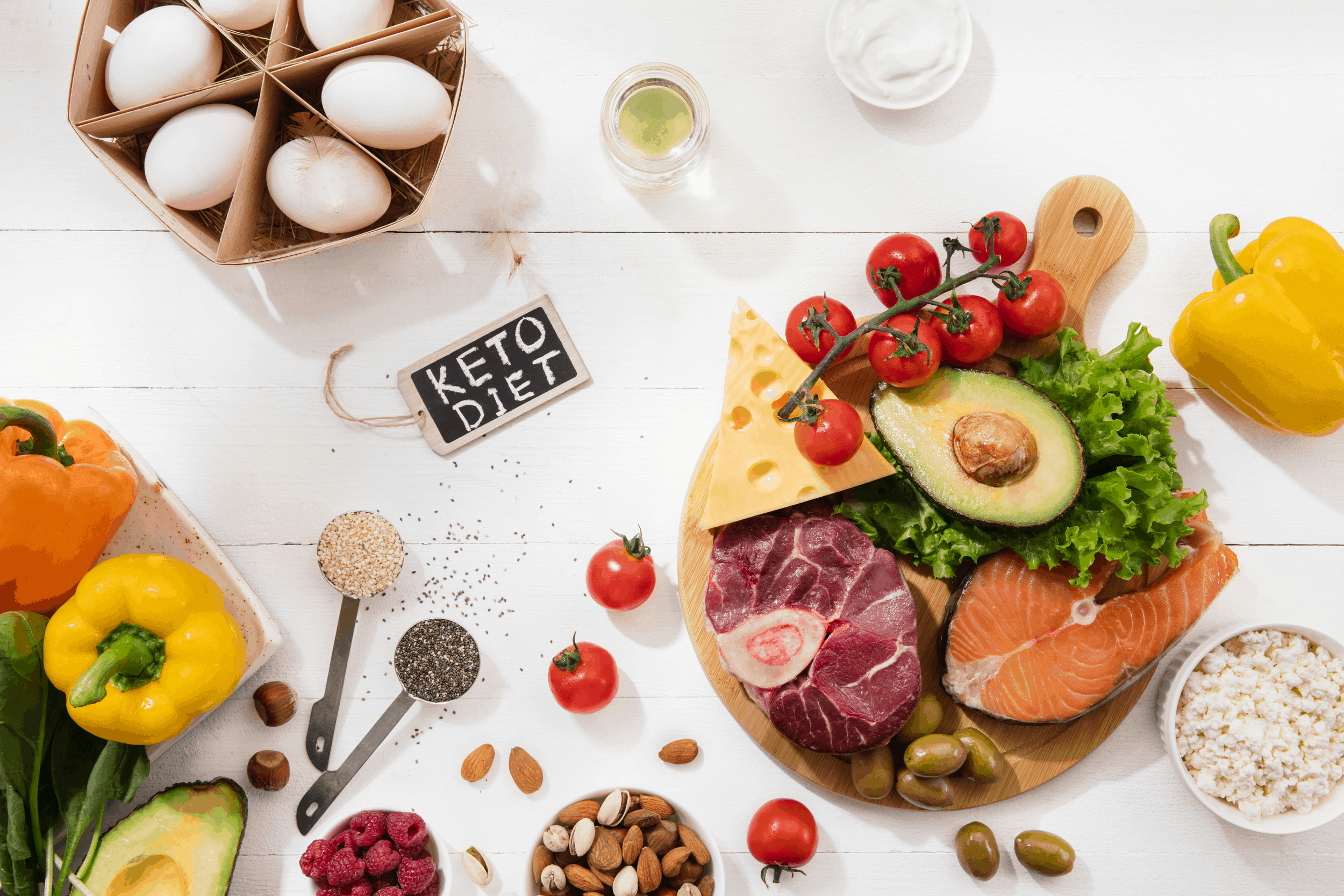WHAT ARE KETOGENIC DIETS?
Ketogenic diets or very low carb diets have become extremely popular in the last decade, mainly as diets for weight loss. Although the media refers to a single ketogenic diet, in reality, there are four categories to which, recently, the Mediterranean ketogenic diet has been added.
Ketogenic diets have been used systematically to treat refractory epilepsy in children since the early 1920s. In the 1970s, the Atkins diet became one of the most popular methods of treating obesity because it does not require calorie counting or portion limitation.
Subsequent research has shown the therapeutic potential of ketogenic diets in type 2 diabetes, polycystic ovary syndrome, epilepsy in children and adults, cancer, and their ability to ameliorate the risk factors of cardiovascular disease.
Ketogenic diets prevent the onset of cardiovascular disease primarily by reducing body weight and improving the lipid profile. In addition, ketogenic diets decrease the concentration of plasma triglycerides and cholesterol, increase the concentration of HDL cholesterol and the size of LDL particles.
PHYSIOLOGICAL MECHANISMS OF KETOGENIC DIETS
Ketogenic diets are characterized by a reduced dietary intake of carbohydrates (usually less than 50g per day) and a relative increase in protein and lipids. When the diet is low or low in carbohydrates, insulin secretion decreases, which leads to inhibition of lipogenesis and lipid deposition in the form of reserve triglycerides.
After a few days of fasting or a drastic decrease in carbohydrate intake, glucose reserves decrease and can no longer provide oxaloacetate to the Krebs cycle nor energy support to the nervous system. After 3-4 days, the nervous system begins to use acetyl-CoA as an alternative energy source resulting from the intensification of β-oxidation of fatty acids mobilized from deposits. In such a situation, encountered for example, in type 1 diabetes, prolonged fasting, or diets high in fat and low in carbohydrates, the production of ketone bodies (acetoacetate, β-hydroxybutyrate, and acetone) in the liver is intensified and installed. The main ketone body synthesized in the liver is acetoacetate, but the highest plasma concentration is β-hydroxybutyrate (resulting from the reduction of acetoacetate).
Under the conditions of an adequate dietary intake of carbohydrates, the production of ketone bodies is negligible. They are metabolized rapidly, especially in skeletal muscle and the myocardium, but also in other tissues. In carbohydrate deficiency, there is an overproduction of acetoacetate that accumulates partly in tissues and is partially converted to the other two ketone bodies, with the appearance of ketonemia (the presence of ketone bodies in the blood) and ketonuria (elimination of ketone bodies in urine).
Ketosis is a physiological process unlike ketoacidosis in type 1 diabetes. In physiological ketosis, ketonemia reaches a maximum of 7-8 mmol / l, and blood pH does not change. In uncontrolled diabetic ketoacidosis, ketonemia can exceed 20 mmol / l, and blood pH drops below 7.3.
TYPES OF KETOGENIC DIETS
There are four types of ketogenic diets that differ in the ratio of ketogenic fats: protein plus carbohydrates. The higher the percentage, the smaller the variations in ketonemia and the variety of foods that can be consumed. The fifth option, the Mediterranean ketogenic diet, ignores the ketogenic ratio and replaces foods rich in carbohydrates, typical of the Mediterranean diet, with fruits and vegetables low in fructose and starch.
The Classic Ketogenic Diet
This diet is especially recommended for children with refractory epilepsy. It uses a fat: protein plus carbohydrate ratio (in grams) of 4: 1. It allows the consumption of foods rich in lipids (cream, butter, vegetable oils), fruits, and vegetables with low carbohydrate content and prohibits the consumption of foods rich in carbohydrates (sugar, pasta, bread, cereals). In older children, in whom the need for protein increases, a ratio of 3: 1 can be used.
This classic ketogenic diet is a difficult diet to follow because it requires weighing food and therefore a long time to prepare the meal. In children, the diet is initiated in the hospital, under strict medical supervision.
Medium-Chain Triglyceride Diet
This medium-chain triglyceride diet is also recommended for children and adolescents with refractory epilepsy, it includes the consumption of triglycerides containing octanoic and decanoic acid extracted from coconut oil by fractionation.
This diet allows the consumption of a higher amount of protein and carbohydrates compared to the classic one, which is why the number of foods that can be eaten is higher and, as a result, easier to follow. Side effects are rarely seen and include gastrointestinal disorders (abdominal pain, diarrhea).
Atkins Diet
The modified Atkins diet differs from the original one. It recommends the consumption of 20g of carbohydrates per day throughout the diet, and the consumption of high-fat foods is mandatory (not acceptable, as initially recommended).
It is a diet that consists of four phases during which carbohydrate intake increases progressively, from 20g per day to 50g per day. The modified diet uses a fat: protein plus carbohydrate ratio of 1.1: 1, does not impose a caloric restriction, and does not require meticulous weighing of food, so preparing meals is easy to do.
The main disadvantage is the relatively large variability of the production of ketone bodies.
Low Glycemic Index Diet
This diet limits the consumption of carbohydrates to 40-60g per day, and they must come from foods with a glycemic index <50. The main advantages of this diet are the great flexibility in adjusting the portions to the variations of the appetite and the freedom to make creative meals by choosing between a relatively large number of foods.
The main disadvantage is the need to know the glycemic index of food.
Mediterranean Ketogenic Diet
The Mediterranean ketogenic diet has two variants, Spanish and Italian, with the addition of vegetable extracts.
Both diets encourage the consumption of olive oil, red wine, foods low in carbohydrates (fruits and vegetables), and fish as the primary source of protein. Both options are hampered by the administration of either nutritional supplements (poly-vitamins and calcium) in the case of the Spanish diet or plant extracts in the Italian diet.
Despite these minor disadvantages, both diets have proven to be easy to follow and are used successfully to improve cardiovascular risk factors.
HOW MANY CARBS CAN BE CONSUMED IN THE KETOGENIC DIETS?
Usually, those who want to start a ketogenic diet will have to consume less than 5-10% of the calories from carbohydrates. In the case of people who need 2000 calories a day for maintenance, they will have to consume less than 200 calories (<50g of carbohydrates per day) to enter the state of ketosis.
Some people can enter ketosis with more carbohydrates per day, others only with a minimum amount, close to 0. Even if we eat less than 10% carbohydrates per day, we must choose those unprocessed carbohydrates. The processed ones can get us out of ketosis by increasing insulin secretion (foods such as sweets, pastries, cakes, or other processed carbohydrates rich in sugar).
It is worthy to note that we can actually quickly reach our daily carbohydrate limit. For example, with a banana of 200 grams, we have already reached 40 grams of carbohydrates.
PERMITTED FOODS IN THE KETO DIETS
Foods allowed in ketogenic diets are meat, cheese, yogurt, sweet milk, nuts, seeds, olives, carbohydrate-poor fruits, vegetables – especially low-carbohydrate greens (spinach, lettuce, cabbage, stevia, nettles, cucumbers, etc.).
In addition, we can use non-caloric sweeteners without carbohydrates, such as stevia, sucrose, or erythritol. A common trap is consuming unhealthy foods but low in carbohydrates, such as processed meat (burgers, sausages, etc.), oils, fried foods, or other processed foods.
Quality foods low in carbohydrates should be chosen: eggs, beef, poultry, fish, oilseeds, olives, many green vegetables, dairy, fruits with few carbohydrates.
PROHIBITED FOODS IN THE KETO DIETS
The following food groups are not allowed in ketogenic diets: carbohydrate-rich fruits, flour products (pasta, bread, etc.), rice, cereals, legumes, polenta, corn, carbohydrate-rich dairy products, and, of course, processed foods rich in sugar, sweets or juices.
PROS OF THE KETO DIET
Has a Therapeutic Effect in Neurological Conditions
Ketogenic diets were designed to treat children with epilepsy who did not respond to conventional treatments and have been in operation since 1920. It has a therapeutic effect in epilepsy through changes in the use of the energy substrate by neurons.
Various studies have found that seizures in children who consumed the keto diet were significantly reduced than those who followed high diets. Also, it has been found to help to prevent neurodegenerative diseases.
Improves Blood Parameters
A ketogenic diet can improve the metabolic profile by lowering triglycerides, LDL cholesterol, blood sugar, insulin resistance, and increasing HDL cholesterol. It has a unique role in the control of diabetes and the improvement of glycosylated hemoglobin.
Reduces Inflammation
Ketosis can help reduce inflammation in the body, make the process smoother, and further help relieve discomfort. Mediating the level of inflammation can prevent and modulate the carcinogenesis process.
May Increases Life Expectancy
After testing the ketogenic diet in laboratory animals, there was a longer average life expectancy found (approximately ten years). An increase in memory, coordination, and strength was observed in old age.
CONS OF THE KETO DIET
Leads to Keto-Flu
At the beginning of a ketogenic diet, most people describe keto-flu satiety, characterized by a state of fatigue, dizziness, nausea, headache, or constipation, which passes later after the body adapts to this diet.
Results in Indisposition and Irritation
Lack of carbohydrates can lower your blood sugar, leaving your mood tired and irritated most of the time. For these reasons, it is advisable to follow these diets under the strict observance of the nutritionist.
Dehydrates the Body
During ketogenic diets, a deficiency of salt and electrolytes may occur. This can be remedied by hydration and proper supplementation.
Risk of Ketoacidosis
People with diabetes treated with insulin, if they consume a low amount of carbohydrates, they tend to have a higher risk of developing hypoglycemia or diabetic ketoacidosis (the pathological state of ketosis that leads to severe hydro-electrolyte imbalances).
Long-Term Side Effects
The long-term effect is not clearly known, as most studies have been conducted for less than two years, so we need more research to know for sure the effect of long-term ketogenic diets.
Hard to Follow
Because they are so restrictive, ketogenic diets are difficult to follow in the long run. Carbohydrates usually represent 50% of a typical diet. One of the main criticisms of this diet is that many people tend to overeat protein and poor-quality fats from processed foods with too few fruits or vegetables.
Needs Specialist Supervision
Unlike other diets that you can manage on a daily basis, the ketogenic diet should be performed only under the supervision of a nutritionist because, although it is associated with multiple health benefits, it does so at the cost of profound changes in the body.
WHO IS NOT RECOMMEDED FOR THE KETO DIET?
The ketogenic diet is not recommended for the following people:
Performance athletes or people with a high level of daily physical activity. Over time, physical performance may return to normal, but the adjustment period can be months or even years;
People with diabetes on insulin treatment;
For children and pregnant women, studies are needed over a longer period to see its effects on the fetal and maternal body;
People accustomed to eating a large amount of carbohydrates throughout the day may have difficulty initiating and maintaining a diet;
The protein-rich ketogenic diet is not recommended for those with kidney problems.
KEY TAKEAWAYS
Although long blamed for their high-fat content, ketogenic diets are a convenient alternative to classic low-calorie diets.
As they do not require caloric restriction or portion limitation, they could be followed for long periods, especially if the weekly menu is planned correctly.
Though ketogenic diets are beneficial for weight loss, help control blood sugar, improve lipid profile, reduce inflammation in the body, and be used to treat epilepsy, they are not suitable for everyone. There are several categories of people with contraindications.
The most important thing to remember for those who decide to start this diet is that a correct and effective ketogenic diet is made with healthy foods and as little processed as possible.
Also, being a diet that temporarily restricts an essential category of macronutrients (carbohydrates), it must be followed by a period in which these foods are introduced gradually to prevent the recovery of lost pounds.
However, given that ketogenic diets have been studied for a relatively short time compared to other diets such as the Mediterranean diet, their long-term adoption should be done with caution for the time being, as there are no longitudinal studies to confirm their safety. Always consult your medical doctor or a health professional before making any changes to your diet.
Article Sources
HealthxTips is committed to delivering content that adheres to highest standard for accuracy, sourcing and objective analysis.
HealthxTips uses only high-quality and trustworthy sources to support the facts in our articles.
1. Dhamija, R., Eckert, S., & Wirrell, E. (2013). Ketogenic diet. The Canadian journal of neurological sciences. Le journal canadien des sciences neurologiques, 40(2), 158–167. https://doi.org/10.1017/s0317167100013676
2. Paoli, A., Rubini, A., Volek, J. S., & Grimaldi, K. A. (2013). Beyond weight loss: a review of the therapeutic uses of very-low-carbohydrate (ketogenic) diets. European journal of clinical nutrition, 67(8), 789–796. https://doi.org/10.1038/ejcn.2013.116
3. Walczyk, T., & Wick, J. Y. (2017). The Ketogenic Diet: Making a Comeback. The Consultant pharmacist : the journal of the American Society of Consultant Pharmacists, 32(7), 388–396. https://doi.org/10.4140/TCP.n.2017.388
4. Zupec-Kania, B. A., & Spellman, E. (2008). An overview of the ketogenic diet for pediatric epilepsy. Nutrition in clinical practice : official publication of the American Society for Parenteral and Enteral Nutrition, 23(6), 589–596. https://doi.org/10.1177/0884533608326138








0 Comments